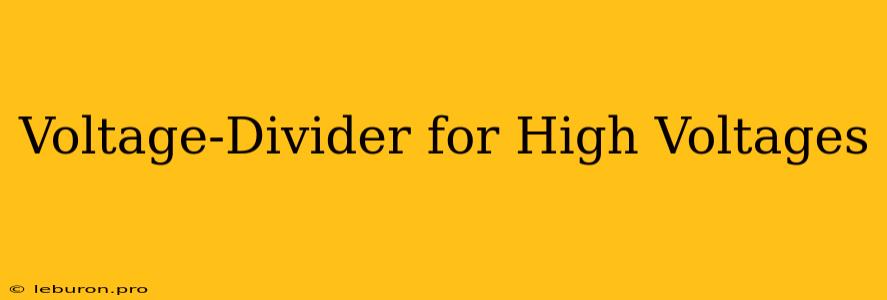The concept of a voltage divider is a fundamental principle in electronics, often used to reduce a higher voltage to a lower, more manageable level. While this technique is commonly applied for lower voltages, it becomes more complex and demands careful consideration when dealing with high voltages. This complexity arises due to factors such as safety concerns, power dissipation, and the influence of parasitic capacitances. This article will explore the intricacies of using a voltage divider for high voltages, delving into the critical considerations and practical implications for successful implementation.
Understanding Voltage Dividers
A voltage divider circuit, in its simplest form, consists of two resistors connected in series. The voltage across the second resistor is a fraction of the total input voltage, determined by the ratio of the two resistances. This principle is embodied in the equation:
Vout = Vin * (R2 / (R1 + R2))
Where:
- Vout is the output voltage across resistor R2
- Vin is the input voltage applied across the series combination of R1 and R2
- R1 and R2 are the resistances of the two resistors
The simplicity of this concept belies the challenges that emerge when dealing with high voltages.
Challenges of High Voltage Voltage Dividers
Safety Concerns
High voltages pose a significant safety hazard, demanding strict precautions. Direct contact with high voltage can result in severe electric shock or even fatality. When designing a high voltage voltage divider, it is imperative to prioritize safety measures. This includes:
- Insulation: Components must be properly insulated to prevent accidental contact with live circuits.
- Enclosure: The circuit should be housed within a robust enclosure, preferably with a protective cover and interlocks to prevent accidental access to live components.
- Grounding: Proper grounding is essential for safely dissipating stray currents and preventing dangerous electrical potentials from accumulating.
Power Dissipation
The resistors in a voltage divider circuit will dissipate power, which can be substantial with high voltages. The power dissipated in each resistor can be calculated using:
P = V^2 / R
Where:
- P is the power dissipated (in Watts)
- V is the voltage across the resistor
- R is the resistance of the resistor
High power dissipation can lead to excessive heat generation, requiring suitable resistors with a high power rating. Additionally, appropriate heat sinks or ventilation may be necessary to prevent overheating and component failure.
Parasitic Capacitances
Parasitic capacitances, unintended capacitances that exist between components or conductors, become more significant at high voltages. These capacitances can influence the voltage divider's performance, introducing inaccuracies and potential instability. The effect of parasitic capacitances can be minimized by using components with low parasitic capacitance values and by carefully routing conductors to reduce the capacitance between them.
Design Considerations for High Voltage Voltage Dividers
Resistor Selection
Resistors used in high voltage dividers require careful selection. Key considerations include:
- Voltage Rating: The resistors must have a voltage rating exceeding the maximum voltage encountered in the circuit.
- Power Rating: The resistors must be capable of handling the power dissipation without overheating.
- Stability: Resistors with a high level of temperature stability will minimize variations in the voltage division ratio due to temperature changes.
Component Placement
Physical layout of the components can influence the performance of a high voltage voltage divider. Optimizing component placement to minimize parasitic capacitances is crucial.
Shielding
Shielding can be employed to minimize the influence of external electromagnetic interference (EMI) on the voltage divider. Shielding can involve surrounding the circuit with a conductive material, such as a metal enclosure, to isolate it from electromagnetic fields.
Applications of High Voltage Voltage Dividers
High voltage voltage dividers find applications in a wide range of fields, including:
- Power Systems: Dividing high voltage lines for measurement and control purposes
- High Voltage Testing: Generating safe, reduced voltages for testing high voltage equipment and components
- Electrostatic Discharge Protection: Protecting sensitive electronic equipment from electrostatic discharges
Conclusion
Using a voltage divider for high voltages presents a unique set of challenges requiring careful design considerations and meticulous safety practices. From selecting appropriate resistors and ensuring proper insulation to minimizing parasitic capacitances and managing power dissipation, every stage of the design process demands attention to detail. By addressing these challenges, engineers can safely and effectively implement voltage dividers for high voltage applications, enabling accurate measurement, control, and protection in a variety of critical systems. Understanding the complexities of high voltage dividers is crucial for ensuring safety and reliable operation in high voltage environments. As technology progresses and the demand for higher voltages increases, the ability to design and implement these circuits safely and efficiently becomes ever more important.
